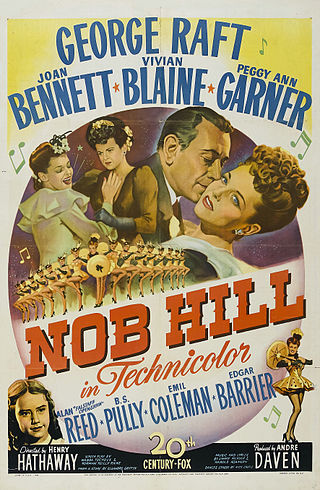
Ginger Rogers was an American actress, dancer and singer during the Golden Age of Hollywood. She won an Academy Award for Best Actress for her starring role in Kitty Foyle (1940), and performed during the 1930s in RKO's musical films with Fred Astaire. Her career continued on stage, radio and television throughout much of the 20th century.

Cornel Wilde was a Hungarian-American actor and filmmaker.

George Raft was an American film actor and dancer identified with portrayals of gangsters in crime melodramas of the 1930s and 1940s. A stylish leading man in dozens of movies, Raft is remembered for his gangster roles in Quick Millions (1931) with Spencer Tracy, Scarface (1932) with Paul Muni, Each Dawn I Die (1939) with James Cagney, Invisible Stripes (1939) with Humphrey Bogart, and Billy Wilder's comedy Some Like It Hot (1959) with Marilyn Monroe and Jack Lemmon; and as a dancer in Bolero (1934) with Carole Lombard and a truck driver in They Drive by Night (1940) with Ann Sheridan, Ida Lupino and Bogart.

Peggy Ann Garner was an American child actress.

42nd Street is a 1933 American pre-Code musical film directed by Lloyd Bacon, with songs by Harry Warren (music) and Al Dubin (lyrics). The film's numbers were staged and choreographed by Busby Berkeley. It stars an ensemble cast of Warner Baxter, Bebe Daniels, George Brent, Ruby Keeler, Dick Powell and Ginger Rogers.

Billie Honor Whitelaw was an English actress. She worked in close collaboration with Irish playwright Samuel Beckett for 25 years and was regarded as one of the foremost interpreters of his works. She was also known for her portrayal of Mrs. Baylock, the demonic nanny in the 1976 horror film The Omen.

Desperate Living is a 1977 American black comedy film directed, produced, and written by John Waters. The film stars Liz Renay, Mink Stole, Susan Lowe, Edith Massey, Mary Vivian Pearce, and Jean Hill.
Black widow may refer to:

Mr. Hobbs Takes a Vacation is a 1962 American comedy film directed by Henry Koster and starring James Stewart and Maureen O'Hara. The film is based on the novel Mr. Hobbs' Vacation, by Edward Streeter and features a popular singer of the time, Fabian.

Marguerite Churchill was an American stage and film actress whose career lasted 30 years, from 1922 to 1952. She was John Wayne's first leading lady, in The Big Trail (1930).

Rescue from Gilligan's Island is a 1978 made-for-television comedy film that continues the adventures of the shipwrecked castaways from the 1964–67 sitcom Gilligan's Island, starring Bob Denver and Alan Hale Jr., and featuring all the original cast except Tina Louise. The film first aired on NBC as a two-part special on October 14 and October 21, 1978. The film has the characters finally being rescued after 15 years on the island. The film was directed by Leslie H. Martinson.

Roxie Hart is a 1942 American comedy film directed by William A. Wellman, and starring Ginger Rogers, Adolphe Menjou and George Montgomery. A film adaptation of a 1926 play Chicago by Maurine Dallas Watkins, a journalist who found inspiration in two real-life Chicago trials she had covered for the press. The play had been adapted once prior, in a 1927 silent film. In 1975, a hit stage musical premiered, and was once more adapted as the Oscar-winning 2002 musical film.

Nob Hill is a 1945 Technicolor film about a Barbary Coast, San Francisco, United States saloon keeper, starring George Raft and Joan Bennett. Part musical and part drama, the movie was directed by Henry Hathaway. It remains one of Raft's lesser known movies even though it was a big success, in part because it was a musical.

Mary Eugenia Rawls was an American actress.

Tight Spot is a 1955 American film noir crime film directed by Phil Karlson and starring Ginger Rogers, Edward G. Robinson and Brian Keith. The story was inspired by then prominent U.S. Senator Estes Kefauver's strong-arm tactics in coercing Virginia Hill to testify in the infamous Bugsy Siegel organized crime prosecution. The Democratic senator from Tennessee attracted national attention with the new medium of televised investigation hearings on Capitol Hill in Washington, D.C. The next year saw Kefauver as the Vice Presidential nominee with former Illinois Governor Adlai Stevenson II for the Democrats in the 1956 election against Republican incumbent 34th president Dwight D. Eisenhower and his running mate Richard M. Nixon, who were reelected.

The Rebels is a historical novel written by John Jakes, originally published in 1975, the second in a series known as The Kent Family Chronicles or the American Bicentennial Series. The novel mixes fictional characters with historical events and figures, to narrate the story of the nascent United States of America during the time of the American Revolution. While the novel continues the story of Philip Kent, started in The Bastard, a large portion focuses on Judson Fletcher, a newly introduced character, as a different rebel. In 1979, the novel was made into a television film by Operation Prime Time.

Teenage Rebel is a 1956 American drama film directed by Edmund Goulding and starring Ginger Rogers, Michael Rennie and Mildred Natwick. It was nominated for two Academy Awards; Best Costume Design and Best Art Direction.

How to Be Very, Very Popular is a 1955 American comedy film written, produced and directed by Nunnally Johnson. The film starred Betty Grable in her final film role and Sheree North in her first leading role.

Forever Female is a 1953 black and white film directed by Irving Rapper. It stars Ginger Rogers and William Holden. It won a Golden Globe in 1954.

Magnificent Doll is a 1946 American historical drama film directed by Frank Borzage and starring Ginger Rogers as Dolley Madison and David Niven as Aaron Burr. The supporting cast features Burgess Meredith as James Madison and Grandon Rhodes as Thomas Jefferson. The screenplay was written by Irving Stone.



















